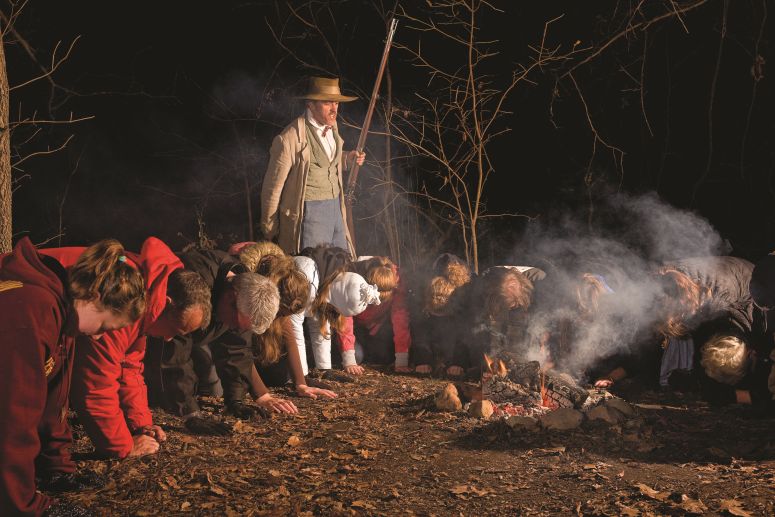Historical events converge this week; families can participate


“You are dumber than my hogs!”
Could someone actually say that to me? Yes, in 1836—if I were a slave.
And that’s the role I’m playing here at Conner Prairie, the living history museum outside Indianapolis where during this special Follow the North Star program, I’m a slave about to be sold in Indiana. I’m treated like an animal—a brood mare to be exact. The potential owners only care about “how many darkies I can drop,” or whether I can cook or sew.
“Don’t you lie to me!” one potential buyer warns. “You stupid dumb darkie! And even worse, it is an African American slave owner yelling at me. (Yes, there were African Americans who were slave holders.)
I can’t think of a better time than the week we celebrate Martin Luther King Day and the 150th Anniversary of the Emancipation Proclamation to embrace teachable moments with kids about slavery—no more so than at the Lincoln Memorial and Martin Luther King Memorial in Washington DC.
Did you know George Washington made provisions in his will to free all of his own slaves but could not free those (or the descendants of those) whom Martha had brought to their marriage. You can visit the Slave Memorial at Mount Vernon.
At Colonial Williamsburg in Va, families can explore what it was like to be African American during Revolutionary era when more than half of all African Americans lived in Virginia and Maryland. Most blacks lived in the Chesapeake region, where they made up more than 50 to 60 percent of the overall population. The majority, but not all, of these African Americans were slaves.
In Indiana on the day I’ve time traveled back to 1836 and become a slave, I’m frightened and angry, separated from my family. I don’t know if Ill ever see my husband or children again. But when my chance comes for freedom, I risk everything and take it—I run away.
I start a long tortuous trip on the Underground Railroad., the journey that would have taken 3-5 years takes us just 90 minutes.
The estimates are anywhere from 20,000 to 200,000 slaves started that journey to freedom in the north along the Underground Railroad, helped by abolitionists and runaway slaves and freed blacks and Quakers along the way.
Follow the North Star is only offered at night in November and April and to school groups other times of the year. At Conner Prairie’s Civil War Experience, we can use 21st century technology to see the Civil War from the perspective of a small Indiana town struggling to protect itself from Confederate Raiders (which buildings would you protect?) and get the chance to join the Cavalry.

But nothing is more powerful than stepping into the shoes of an escaped slave. The story line: Our owner has brought us to Indiana not realizing he must pay a $500 bond on each of us—imposed by the state for free as well as enslaved African American s. Rather than pay that exorbitant amount, he resolves to sell us back south. When he’s not looking, the twelve of us run away. There’s danger everywhere—slave catchers who would turn us in for bounty.
We first encounter some farm wives who couldn’t be less friendly, though they tell us they re god-fearing people who don’t believe in slavery. “You’ve got a right to freedom but not here!” they say, as their teenaged daughters show us the road toward Roberts Settlement, a free black community about 15 miles away, we’re told.
“Follow the North Star. “Look for a red cloth on a door or a lantern in the window- those are signs, they tell us of people who will help on our journey.”
Down the road, we meet an escaped slave named Jack Hunter who made it to freedom in Detroit but is now returning to the South to find his wife Annie and his son Henry. It hurts that my son is growing up not knowing who his daddy is!”
We’re hungry and tired. And then disaster strikes. We meet a distraught out of work carpenter who blames us for his woes…even his wife’s death. “How can I compete when you work for free?” he yells. When he goes to find rope to tie us up — so he can turn us in for the bounty ($500 for each us) — we run toward the Quaker home nearby.
“A friend of a friend sent us,” one of us says whispering at the door as the rest of us stay hidden. They let us rest and give us cornbread. “You’re safe here,” they tell us.
“We do not believe God would want anyone to be slaves. You can count on friends to help you….”
Mrs. Ward, a black woman who lives nearby, points us toward Robert’s Settlement where we can blend in with the other African Americans and rest before continuing on our journey to Michigan and Canada.
Sadly, we learn, fewer than half those who set out on the Underground Railroad made it to freedom.
This month, let’s celebrate those who tried—and those who helped them.
